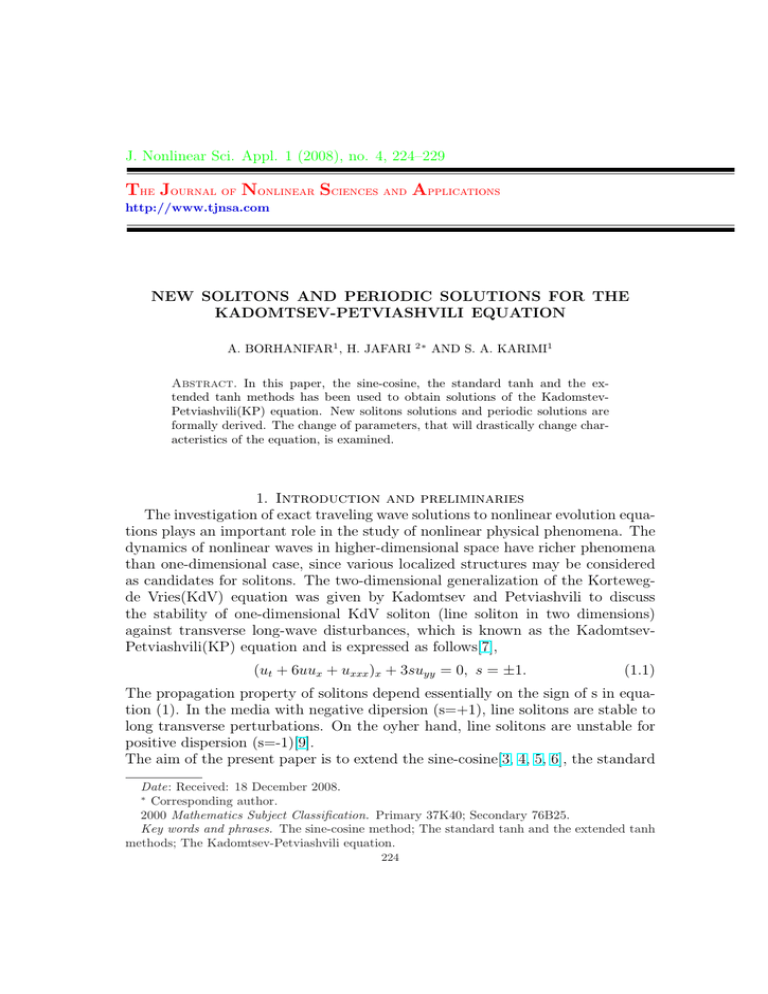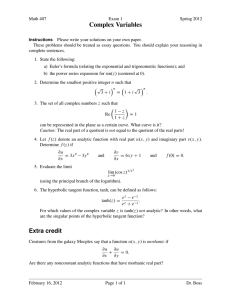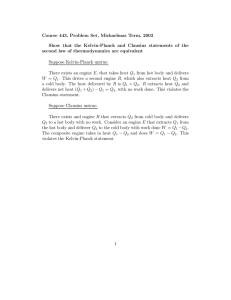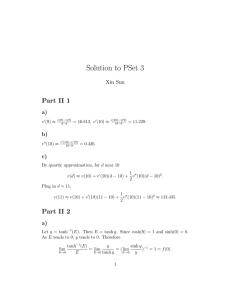T J N S
advertisement

J. Nonlinear Sci. Appl. 1 (2008), no. 4, 224–229
The Journal of Nonlinear Sciences and Applications
http://www.tjnsa.com
NEW SOLITONS AND PERIODIC SOLUTIONS FOR THE
KADOMTSEV-PETVIASHVILI EQUATION
A. BORHANIFAR1 , H. JAFARI
2∗
AND S. A. KARIMI1
Abstract. In this paper, the sine-cosine, the standard tanh and the extended tanh methods has been used to obtain solutions of the KadomstevPetviashvili(KP) equation. New solitons solutions and periodic solutions are
formally derived. The change of parameters, that will drastically change characteristics of the equation, is examined.
1. Introduction and preliminaries
The investigation of exact traveling wave solutions to nonlinear evolution equations plays an important role in the study of nonlinear physical phenomena. The
dynamics of nonlinear waves in higher-dimensional space have richer phenomena
than one-dimensional case, since various localized structures may be considered
as candidates for solitons. The two-dimensional generalization of the Kortewegde Vries(KdV) equation was given by Kadomtsev and Petviashvili to discuss
the stability of one-dimensional KdV soliton (line soliton in two dimensions)
against transverse long-wave disturbances, which is known as the KadomtsevPetviashvili(KP) equation and is expressed as follows[7],
(ut + 6uux + uxxx )x + 3suyy = 0, s = ±1.
(1.1)
The propagation property of solitons depend essentially on the sign of s in equation (1). In the media with negative dipersion (s=+1), line solitons are stable to
long transverse perturbations. On the oyher hand, line solitons are unstable for
positive dispersion (s=-1)[9].
The aim of the present paper is to extend the sine-cosine[3, 4, 5, 6], the standard
Date: Received: 18 December 2008.
Corresponding author.
2000 Mathematics Subject Classification. Primary 37K40; Secondary 76B25.
Key words and phrases. The sine-cosine method; The standard tanh and the extended tanh
methods; The Kadomtsev-Petviashvili equation.
∗
224
SOLITONS AND PERIODIC SOLUTIONS FOR KP EQN.
225
tanh[1, 2] and the extended tanh[7, 8] methods to finding new solitons and periodic solutions for nonlinear KP equation.
The paper has been organized as follows. Section 2 gives analysis of methods. In
section 3 application of the sine-cosine method is considered for the KadomtsevPetviashvili(KP) equation. section 4 gives application of standard tanh and extended tanh methods for the Kp equatin. Discussion and conclusion are presented
in section 5.
2. Analysis of method
For the sine-cosine, standard tanh and extended tanh methods, we first unite
the independent variable x, y and t into one wave variable ξ = x + y − ct, to carry
out a P DE in two independent variables
P (u, ut , ux , uy , uxx , uyy , ...) = 0 or
R(u, utt , ux , uy , uxx , uyy , ...) = 0,
(2.1)
into an ODE
Q(u, u0 , u00 , u000 , ...).
(2.2)
Eq.(2.2) is then integrated as long as all terms contain derivatives. Usually the
integration constants are considered to be zeros in view of the localized solutions.
2.1. The sine-cosine method. The solutions of the reduced ODE equation
can be expressed in the form
½
π
λcosβ (µξ), |µξ| ≤ 2µ
,
u(x, y, t) =
(2.3)
otherwise,
0,
or in the form
½
u(x, y, t) =
λsinβ (µξ), |µξ| ≤ πµ ,
otherwise,
0.
(2.4)
Where λ, µ and β are parameters that will be determined, in Eqs.(2.3),(2.4) µ
and c are the wave number and the wave speed respectively. The assumption
(2.3) gives
u2 (ξ) = λ2 cos2β (µξ),
(2.5)
u00 (ξ) = −µ2 β 2 λcosβ (µξ) + µ2 β(β − 1)λcosβ−2 (µξ)
(2.6)
where similar equations can be obtained for the sine assumption. Substituting
the sine-cosine assumption and their derivatives into the reduce ODE gives a
trigonometric equation of cosK (µξ) or sinK (µξ) terms. The parameters are then
determined by first balancing the exponents of each pair of cosine or sine determine K. We next collect all coefficients of the same power in cosk (µξ) or sink (µξ),
where these coefficients have to vanish. This gives a system of algebraic equations among the unknowns c, λ, µ and ξ that will be determined. The solutions
proposed in (2.3) and (2.4) follow immediately.
226
A. BORHANIFAR, H. JAFARI, S. A. KARIMI
2.2. The standard tanh and extended tanh methods. The standard tanh
method is developed by Malfliet[1, 2] where the tanh is introduced as a new
variable, since all derivatives of a tanh are represented by a tanh itself. The tanh
method introduces a new independent variable
Y = tanh(µξ),
(2.7)
that leads to the changes of derivatives:
d
d
= µ(1 − Y 2 )
dξ
dY
,
2
d2
d
2
2
2 d
=
µ
(1
−
Y
)(−2Y
+
(1
−
Y
)
). (2.8)
dξ 2
dY
dY 2
The solutions for the standard tanh method can be proposed as a finite power
series in Y in the form
u(µξ) = S(Y ) =
M
X
ak Y k .
(2.9)
k=0
The extended tanh method [7, 8] admits the use of the finite expansion
u(µξ) = S(Y ) =
M
X
k
ak Y +
k=0
M
X
bk Y −k .
(2.10)
k=1
Where the parameter M is a positive , in most cases, that will be determined. To
determine the parameter M , we usually balance the linear terms of highest order
in the resulting equation with the highest order nonlinear terms.We then collect all
coefficients of powers of Y in the resulting equation where these coefficients have
to vanish. This will give a system of algebraic equations involving the parameters
ak , (k = 0, ..., M ), µ, ξ and c for the standard tanh method and the parameters
ak , (k = 0, ..., M ), bk (k = 1, ..., M ), µ, ξ and c for the extended tanh method.
Having determined these parameters we obtain an analytic solution u(x, y, t) in
a closed form.
3. Using the sine-cosine method
A nonlinear KP equation is given by
(ut + 6uux + uxxx )x + 3suyy = 0, s = ±1.
(3.1)
Substituting u(x, y, t) = u(ξ), where the wave variable is ξ = x + y − ct, carries
out Eq.(3.1) to the ODE
(−cu0 + 3(u2 )0 + u000 )0 + 3su00 = 0.
(3.2)
Twice integrating (3.2), setting the constant of integrating to zero, we obtain
(3s − c)u + 3u2 + u00 = 0.
(3.3)
Substituting cosine anstaz(2.4) into (3.3) gives
(3s − c)λcosβ (µξ) + 3λ2 cos2β (µξ) − λµ2 β 2 cosβ (µξ) + λµ2 β(β − 1)cosβ−2 (µξ) = 0
(3.4)
SOLITONS AND PERIODIC SOLUTIONS FOR KP EQN.
227
Equating the exponents of the second and the last cosine functions in above
equation, collecting coefficients of each pair of cosine functions of like exponents,
and setting it equal to zero, we obtain the following system of algebraic equations:
β − 1 6= 0,
β − 2 = 2β,
(3.5)
3s − c = µ2 β 2 ,
−3λ = µ2 β(β − 1),
so that this gives
β = −2,
√
µ = 12 3s − c,
λ = 12 (3s − c),
and c is any real number.
That can also be obtained by using the sine anstaz (2.4).
For 3s − c > 0 this leads to the periodic solutions:
·
¸
1
1 √
2
u1 (x, y, t) = (3s − c) sec
3s − c (x + y − ct) ,
2
2
and for sine anstaz we obtain:
·
¸
1
1 √
2
u2 (x, y, t) = (3s − c) csc
3s − c (x + y − ct) .
2
2
However for 3s − c < 0 we obtain the solitons solutions:
·
¸
1
1 √
2
u3 (x, y, t) = (3s − c) sech
c − 3s (x + y − ct) ,
2
2
¸
·
1
1 √
2
u4 (x, y, t) = − (3s − c) csch
3s − c (x + y − ct) .
2
2
(3.6)
(3.7)
(3.8)
(3.9)
(3.10)
4. Using the standard tanh and the extended tanh methods
We will employ the standard tanh method presented by Malfliet [1, 2] and the
extended tanh method[7, 8].
4.1. Using the standard tanh method. The KP equation given by
(ut + 6uux + uxxx )x + 3suyy = 0, s = ±1,
(4.1)
as shown before, this equation can be transformed to the ODE
(3s − c)u + 3u2 + u00 = 0.
(4.2)
Upon using the wave variable ξ = x + y − ct and twice integrating the resulting
equation.
Balancing u00 with u2 gives
M + 2 = 2M,
(4.3)
so that
M = 2,
(4.4)
the standard tanh method assumes that finite expansion
u(ξ) = a0 + a1 Y + a2 Y 2
,
Y = tanh(µξ),
(4.5)
228
A. BORHANIFAR, H. JAFARI, S. A. KARIMI
Substituting (4.5) into (4.2) and using (2.8), collecting the coefficients of Y j , 0 ≤
j ≤ 4, and equating this coefficients to zero and solving the system of algebraic
for a0 , a1 , a2 , µ and c , we find the following set of solution:
a = 2µ2 ,
0
a1 = 0,
(4.6)
a2 = −2µ2 ,
c = 3s + 4µ2 ,
and µ is any real number.
Substituting (4.6), into (4.5)gives
u5 (x, y, t) = 2µ2 {1 − tanh2 [ µ (x + y − (3s + 4µ2 ) t ) ] },
(4.7)
Eq.(4.7) in turn gives the solitons solution
u6 (x, y, t) = 2µ2 sech2 { µ [ x + y − (3s + 4µ2 )t ] },
(4.8)
4.2. Using the extended tanh method. As shown before, the equation as
follows:
(3s − c)u + 3u2 + u00 = 0,
(4.9)
is the transformed ODE of the KP equation with using the wave variable ξ =
x + y − ct and twice integrating the resulting equation.
Balancing u00 with u2 gives
M + 2 = 2M,
(4.10)
so that
M = 2,
(4.11)
the extended tanh method assumes that finite expansion
u(ξ) = a0 + a1 Y + a2 Y 2 + b1 Y −1 b2 Y −2
,
Y = tanh(µξ).
(4.12)
Substituting (4.12) into (4.9) and using the (2.8), collecting the coefficients of
Y j , −4 ≤ j ≤ 4 and equating this coefficients to zero and solving the system of
a0 , a1 , a2 , b1 , b2 , µ and c we find the following set of solution:
a1 = b1 = o and µ is any real number, after collecting,
a0 = 2µ2 a1 = 0 a2 = −2µ2 b1 = 0 b2 = 0 c = 4µ2 + 3s,
2
a0 = µ2 a1 = 0 a2 = 0 b1 = 0 b2 = −2µ2 c = −4µ2 + 3s,
3
4 2
a0 = − µ a1 = 0 a2 = −2µ2 b1 = 0 b2 = −2µ2 c = −16µ2 + 3s.
3
The Eq.(4.13) gives:
u7 (x, y, t) = 2µ2 sech2 { µ[ x + y − (3s + 4µ2 ) t ] },
(4.13)
(4.14)
(4.15)
(4.16)
and the Eq.(4.14) gives:
u8 (x, y, t) = −2µ2 csch2 { µ[ x + y − (3s + 4µ2 ) t ] },
(4.17)
SOLITONS AND PERIODIC SOLUTIONS FOR KP EQN.
229
and then the Eq.(4.15) gives:
2
u9 (x, y, t) = 2µ2 {− tan2 [µ(x + y − (3s + 16µ2 )t)] + cot2 [µ(x + y − (3s + 16µ2 )t)]}.
3
(4.18)
Where the three of later equations are solitons solutions for Kadomtsev-Petviashvili(KP)
equation.
5. Conclusion
The sine-cosine, the standard tanh and the extended tanh methods were used
to investigate nonlinear KP equation. The work emphasized our belief the three
methods are powerful technique to handle nonlinear depressive equation, hence
these methods can be used in a wider context. The validity of these methods has
been tested by applying to Kadomtsev-Petviashvili(KP) equation.
Finally it is a promising and powerful method for other nonlinear equations in
mathematical physics.
References
1. Malfliet. W, Hereman. W, The tanh method: I Exact solution of nonlinear evolution and
wave equation, Phys. Scr., 54 (1996) 563-568. 1, 2.2, 4
2. Malfliet .W, Hereman .W, The tanh method: II Perturbation technique for conservative
system, Phys. Scr., 54 (1996) 569-575. 1, 2.2, 4
3. Wazwaz. A. M, Partial Differential Equations:
Methods and Applications,
Balkema,Rotterdam, 2002. 1
4. Wazwaz. A. M, Dustinct variants of the KdV equation with compact and noncompact
structures, Appl. Math. Comput., 150 (2004) 365-377. 1
5. Wazwaz. A. M, Variants of the generalized KdV eauation with compact and noncompact
structures, Comput. Math. Appl., 47 (2004) 583-591. 1
6. Wazwaz. A. M, An analytical study of the compactons structures in a class of nonlinear
dispersive equation, Math Comput Simulation.,63(1) (2003) 35-44. 1
7. Wazwaz. A. M, A computational approachto soliton solutions of the Kadomtsev-Petviashili
equation, Comput. Math. Appl.,123(2) (2001) 205-217. 1, 1, 2.2, 4
8. Wazwaz. A. M, The extended tenh method for Zhakharov-Kkuznetsov (ZK) equation, the
modified ZK equation and its generalized forms,Communications in Nonlinear Science and
Numerical Simulation,13(6) (2008) 1039-1047. 1, 2.2, 4
9. Wazwaz. A. M, Multiple-front solutions for the Burgers-Kadomtsev-petviashvili equation,
Applied Mathematics and Computation. 200 (2008) 437-443. 1
1
Department of Mathematics, University of Mohaghegh Ardabili,Ardabil,
Iran.
E-mail address: borhani@uma.ac.ir, karimi s@math.com
2
Department of Mathematics and Computer science, University of Mazandaran,P. O. BOX 47416-95447 Babolsar, Iran,
E-mail address: jafari@umz.ac.ir







